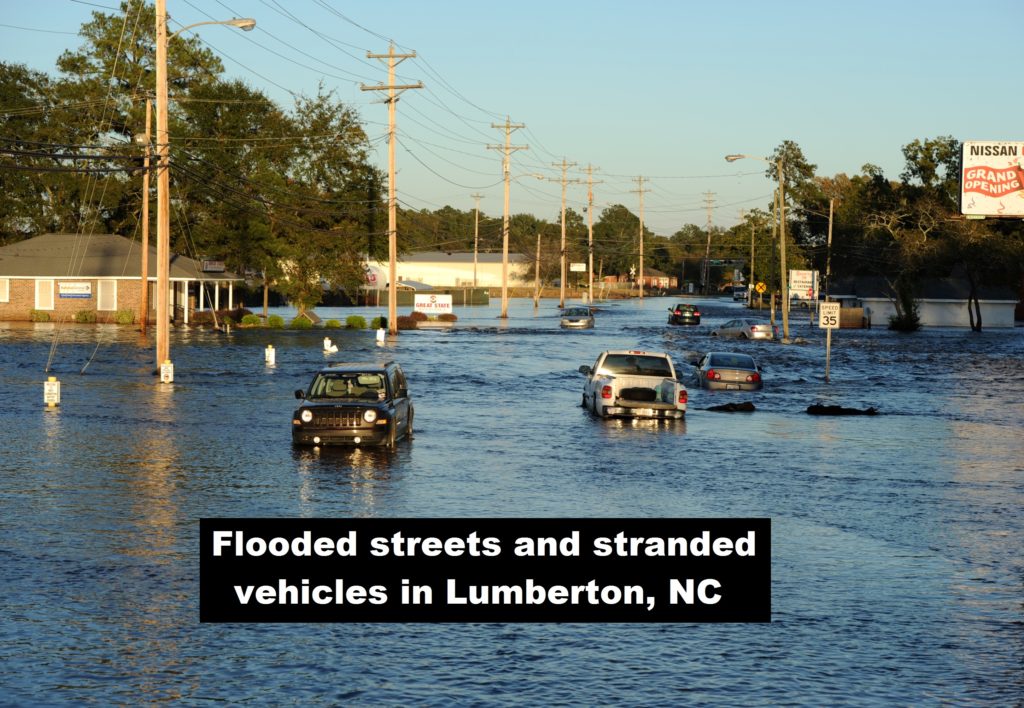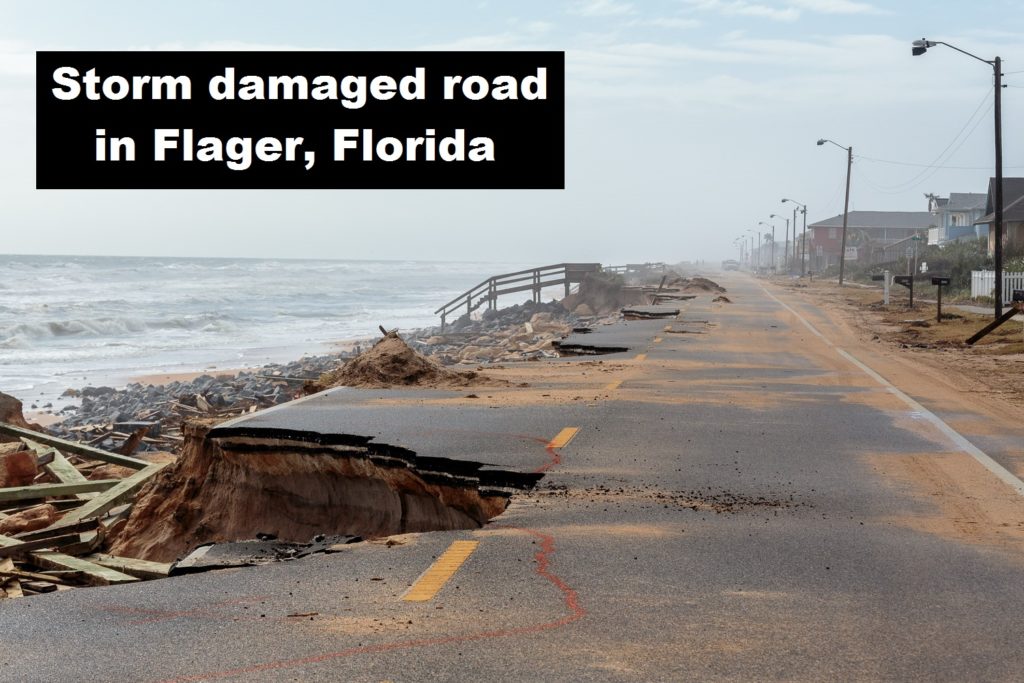Disaster by Design/ Safety by Intent #59
Safety by Intent
With ample warning, Hurricane Matthew made landfall in South Carolina coast on October 8, 2016, bringing along its heavy rainfall and high winds.
The Federal Emergency Management Agency conducted Disaster Initiated Reviews for nuclear plants in South Carolina, North Carolina and Florida to determine whether Hurricane Matthew adversely affected emergency planning measures within a 10-mile radius of each site.H.B. Robinson Steam Electric Plant (Hartsville, SC)
The Robinson nuclear plant was operating at 100 percent power on October 8, 2016, when perturbations on the electrical grid caused by Hurricane Matthew caused the automatic shutdown of the reactor. The onsite emergency diesel generators provided backup power to essential equipment onsite.
FEMA’s Disaster Initiated Review found that all 61 pole-mounted emergency sirens that notify the population in event of an accident at Robinson were operable, with about half (30 sirens) on battery backup power due to localized loss of electricity. FEMA verified that Duke Energy had a plan to replace the batteries before their 7-day capacity became depleted. FMEA further verified that the counties within 10 miles of the site had the resources to conduct alternate alerting if that need arose.
FEMA found that Florence Country opened six shelters to accommodate persons displaced by Matthew while Darlington and Lee Counties had opened one shelter. But FEMA’s consultations with county officials found that sufficient resources existed to handle additional needs in event of a nuclear plant accident. And FEMA verified that the storm had not degraded critical transportation routes and assets within the 10-mile emergency planning zone or depleted shelter and care facilities.
FEMA concluded that Matthew had not impacted its pre-storm finding that emergency planning measures for the Robinson plant remained adequate.
Brunswick Steam Electric Plant (Southport, NC)
The State of North Carolina and both Brunswick and New Hanover counties activated their emergency operations centers because of Hurricane Matthew. The two reactors at the Brunswick nuclear plant continued operating throughout the storm.

Fig. 1 Lumberton, NC, October 11, 2016. (Source: Jocelyn Augustino/FEMA)
FEMA’s Disaster Initiated Review found that all 38 pole-mounted emergency sirens that notify the population in event of an accident at Brunswick were operable on normal power with battery backup power available. The New Hanover County emergency operations center in Wilmington deactivated on October 10 while the Brunswick County emergency operations center in Bolivia remained activated due to flooding in the southern part of the county. FEMA found that state and local resources remained sufficient to handle a nuclear plant accident.
FEMA learned that the storm caused intermittent lapses of the primary communications links between the Brunswick plant and offsite emergency operations centers, but that the secondary satellite communications system functioned per design and a tertiary communications system remained available.
FEMA found that two shelters in New Hanover County and three shelters in Brunswick County had been opened to accommodate persons displaced by Matthew. All five shelters had been closed when no longer needed following the storm. FEMA found that state and local resources remained sufficient to handle a nuclear plant accident.
FEMA concluded that Matthew had not impacted its pre-storm finding that emergency planning measures for the Brunswick plant remained adequate.
Shearon Harris Nuclear Power Plant (New Hill, NC)
The Harris nuclear plant had just begun a scheduled refueling outage. Workers shut down the reactor the previous day. After Matthew’s landfall, the Duke Energy Control Center notified plant workers about perturbations on the electrical grid caused by the storm. Following this notification, outage-related activities were suspended and the plant was disconnected from the grid and placed on backup power from the onsite emergency diesel generators. After the storm subsided, workers reconnected the plant to the electrical grid and resumed refueling activities.
FEMA’s Disaster Initiated Review found that the 83 pole-mounted emergency sirens around the site that notify the population in event of an accident at Harris were operable. FEMA additionally determined that the state and local authorities had sufficient resources remaining to perform functions such as independent radiological dose assessments and field monitoring in event of an accident. And FEMA verified that the storm had not degraded critical transportation routes and assets within the 10-mile emergency planning zone or depleted shelter and care facilities.
FEMA concluded that Matthew had not impacted its pre-storm finding that emergency planning measures for the Harris plant remained adequate.
St. Lucie Plant (Jensen Beach, FL)
Hurricane Matthew impacted the emergency planning zone for the St. Lucie plant beginning on October 6 as it traveled off the eastern coast of Florida as a Category 4 storm. The State of Florida activated its emergency operations center on October 4; St. Lucie County and Martin County activated their emergency operations centers on October 6.
FEMA’s Disaster Initiated Review found that 90 emergency sirens around the site provided notification of the public in event of an accident at St. Lucie. The storm disabled one siren and caused 23 other sirens to rely on battery backup power. FEMA confirmed the plant owner’s plan to fix the broken siren within four days and to replace the batteries on the sirens without electricity supply within five days to ensure their continued operability.

Fig. 2. Flagler, FL (Source: Steve Zumwalt/FEMA)
FEMA met with Brevard County officials on October 8 upon being notified that due to supporting persons evacuated due to Matthew, the county could not support additional evacuees in event of a nuclear plant accident. During that meeting, a contingency reception center was established with support from the State of Florida and Miami-Dade County emergency management officials should need arise until conditions in Brevard County returned to normal.
FEMA concluded that with the contingency plans in place, the emergency planning measures for the St. Lucie plant remained adequate.
Disaster by Design
Americans are all-too-accustomed to seeing local, state, and federal officials and non-governmental organizations like the American Red Cross respond promptly to help those harmed by a disaster.

Fig. 3 (Source: FEMA)
FEMA certainly pitched in to help those in need following Hurricane Matthew (Fig. 3). Less evident, but no less important, was the effort undertaken by FEMA in parallel with their disaster response activities. FEMA checked whether Matthew damaged the infrastructure or depleted response resources such that the public might not be adequately protected in event of an accident at one of the nuclear plants in the region. Upon finding anything that might undermine public protection, FEMA ensured that contingency measures were in place to sustain the necessary protection levels.
Disaster response and disaster readiness are two side of the same coin. FEMA demonstrated capabilities in both areas following Matthew.
—–
UCS’s Disaster by Design/ Safety by Intent series of blog posts is intended to help readers understand how a seemingly unrelated assortment of minor problems can coalesce to cause disaster and how effective defense-in-depth can lessen both the number of pre-existing problems and the chances they team up.
